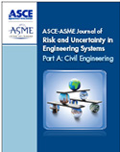
ASCE-ASME Journal of Risk and Uncertainty in Engineering Systems Part A-Civil Engineering
Scope & Guideline
Decoding Uncertainty for Robust Engineering Solutions.
Introduction
Aims and Scopes
- Risk Assessment and Management:
The journal emphasizes methodologies for assessing and managing risks in civil engineering, including probabilistic risk assessment, risk-informed decision-making, and the development of frameworks that incorporate uncertainty into engineering practices. - Uncertainty Quantification:
Research published in the journal frequently addresses uncertainty quantification techniques, providing insights into how uncertainties affect the performance and reliability of engineering systems, particularly in the context of construction and infrastructure. - Innovative Modeling Techniques:
A consistent focus on developing and applying advanced modeling techniques, such as Bayesian networks, machine learning, and stochastic modeling, is evident, aiming to enhance predictive capabilities and decision support systems in civil engineering. - Infrastructure Resilience:
The journal explores themes related to the resilience of civil infrastructure systems, particularly in the face of natural disasters and climate change, promoting research that aims to improve the robustness and adaptability of engineering solutions. - Data-Driven Approaches:
There is a significant emphasis on data-driven methodologies, including the use of big data and machine learning techniques for predictive maintenance, risk assessment, and performance evaluation of engineering systems.
Trending and Emerging
- Climate Change Impact Assessments:
Recent publications increasingly focus on the implications of climate change on infrastructure resilience and risk assessments, highlighting the need for adaptive strategies in civil engineering to address evolving environmental challenges. - Machine Learning and AI in Risk Assessment:
There is a notable surge in studies utilizing machine learning and artificial intelligence for enhancing risk assessment methodologies, predictive modeling, and decision-making processes in engineering systems. - Integrated Risk-Informed Decision Frameworks:
Research is trending towards developing integrated frameworks that combine risk assessment, uncertainty quantification, and multi-criteria decision analysis, reflecting a holistic approach to engineering challenges. - Resilience Engineering:
Emerging themes around resilience engineering focus on ensuring that infrastructure systems can withstand and recover from disruptions, with studies increasingly exploring metrics and methodologies to quantify resilience. - Data Fusion Techniques:
The incorporation of data fusion techniques for combining various sources of data to improve the accuracy and reliability of risk assessments is gaining traction, reflecting advancements in data analytics and sensor technologies.
Declining or Waning
- Traditional Deterministic Approaches:
There is a noticeable decrease in the publication of papers relying solely on traditional deterministic methods for risk assessment and design, as the field increasingly embraces probabilistic and stochastic approaches. - Focus on Generic Risk Models:
Research that applies generic risk models without context-specific adaptation appears to be diminishing, as the trend shifts toward more tailored approaches that address unique challenges faced by specific engineering disciplines. - Static Risk Assessment Methods:
Static methods for risk assessment, which do not account for dynamic environmental or operational changes, are less frequently represented, as the field moves toward more dynamic and adaptive risk management frameworks. - Conventional Material Testing Methods:
The prevalence of papers focused solely on conventional material testing methods has waned, with a growing preference for integrating advanced materials science and technology-driven testing methodologies.
Similar Journals
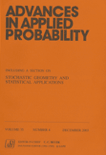
ADVANCES IN APPLIED PROBABILITY
Empowering Research with Applied Probability BreakthroughsADVANCES IN APPLIED PROBABILITY is a prestigious academic journal published by Cambridge University Press, focusing on the critical intersection of applied mathematics and probability theory. With an ISSN of 0001-8678 and an E-ISSN of 1475-6064, this journal emphasizes the development and application of probabilistic models in various sectors, enhancing the rigor and reliability of statistical methodologies. Established in 1969, the journal has evolved with converged years designated up to 2024, maintaining a steady release of cutting-edge research. As a Q2-ranked journal in both Applied Mathematics and Statistics and Probability categories as of 2023, it ranks favorably within the Scopus database, demonstrating its growth in influence and relevance within the academic community, with ranks of 141/278 and 353/635 in its respective fields. Although it does not offer open access, the journal remains a vital resource for researchers, professionals, and students seeking to advance their knowledge and understanding of probability applications across diverse disciplines.

COASTAL ENGINEERING JOURNAL
Connecting Research and Practice in Coastal EngineeringCOASTAL ENGINEERING JOURNAL, published by Taylor & Francis Ltd, stands as a pivotal resource in the fields of Civil and Structural Engineering, Modeling and Simulation, and Ocean Engineering. Since its inception, with publishing spans from 1975 to the present, the journal has fostered innovative research and practical solutions to address the complex challenges posed by coastal environments. With its current positioning in the Q2 category for its respective disciplines in 2023, the journal's rigorous peer-review process ensures that only high-quality studies are disseminated, highlighting its commitment to excellence in scholarly communication. Although currently not an Open Access publication, the journal provides access options that promote wider engagement within the academic community. Researchers, professionals, and students seeking to deepen their understanding of coastal engineering will find a wealth of knowledge in its pages, reinforcing the journal's importance as a leading forum for advanced discourse in this dynamic field.
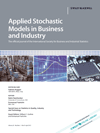
APPLIED STOCHASTIC MODELS IN BUSINESS AND INDUSTRY
Transforming Decision-Making with Advanced Stochastic TechniquesApplied Stochastic Models in Business and Industry, published by Wiley, is a preeminent journal dedicated to advancing the field of stochastic modeling in various business and industry contexts. With an ISSN of 1524-1904 and an E-ISSN of 1526-4025, this journal serves as a vital platform for researchers and practitioners aiming to leverage stochastic techniques to address complex decision-making and operational challenges. The journal holds prestigious rankings, including Q2 in Business, Management and Accounting, and has converged years spanning from 1999 to 2024. It is distinguished by its wide scope, focusing on all aspects of modeling and simulation, as well as decision sciences and operations research. Although it does not operate as an open-access journal, its significant impact factor and Scopus rankings ensure that the valuable insights published within reach a broad audience. By fostering high-quality research and discourse, Applied Stochastic Models in Business and Industry plays a crucial role in driving innovation and excellence in its fields.

Proceedings of the Institution of Mechanical Engineers Part O-Journal of Risk and Reliability
Unveiling the Complexities of Risk and Reliability Engineering.Proceedings of the Institution of Mechanical Engineers Part O – Journal of Risk and Reliability is a highly regarded journal published by SAGE Publications Ltd, specializing in the critical fields of Safety, Risk, Reliability, and Quality. Established in 2006 and extending its coverage until 2024, this journal serves as a vital platform for researchers and professionals to disseminate innovative findings and discuss emerging trends and methodologies related to risk assessment and reliability engineering. With an impact factor that places it in the Q2 quartile of its category and ranked 69th out of 207 in Scopus, it has garnered significant attention within the academic community, ensuring robust visibility and influence. Readers can expect rigorous peer-reviewed articles that contribute to advancing knowledge and practices in the field, fostering a deeper understanding of the complexities and integral practices essential for safety and reliability. As a leading publication within the United Kingdom, it continues to play an instrumental role in shaping contemporary discussions and research in this vital sector.
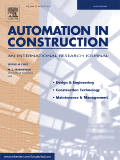
AUTOMATION IN CONSTRUCTION
Exploring the Intersection of Automation and Engineering ExcellenceAUTOMATION IN CONSTRUCTION is a premier academic journal published by Elsevier, dedicated to advancing the fields of Building and Construction, Civil and Structural Engineering, and Control and Systems Engineering. Since its inception in 1992, this journal has served as a vital platform for disseminating innovative research and practical applications in automation technologies within the construction industry. With a distinguished 2023 impact factor reflected in its Q1 ranking across multiple engineering categories—securing rank #3 in Civil and Structural Engineering and rank #3 in Building and Construction—AUTOMATION IN CONSTRUCTION stands out as a leading resource for researchers, professionals, and students keen on staying at the forefront of this rapidly evolving field. The journal offers access to cutting-edge studies that explore automation processes, methodologies, and tools, contributing to the enhancement of productivity and sustainability in construction practices. With contributions from global experts, each issue of AUTOMATION IN CONSTRUCTION provides comprehensive insights that help drive innovation and foster collaboration.

International Journal of Prognostics and Health Management
Pioneering Knowledge in Health Management and Engineering DisciplinesThe International Journal of Prognostics and Health Management (IJPHM), published by the PHM Society, is a leading academic journal dedicated to the interdisciplinary fields of engineering, safety, and risk management. With an ISSN of 2153-2648, this open-access journal has been disseminating pioneering research since its inception in 2010, enabling accessibility to vital advancements in prognostics and health management practices. The journal is recognized for its rigorous peer-reviewed articles, currently holding a prestigious Q2 ranking in multiple categories including Mechanical Engineering and Safety, Risk, Reliability and Quality, along with a Q3 ranking in Civil and Structural Engineering, Energy Engineering and Power Technology, and Computer Science. The journal's commitment to advancing knowledge is underscored by its robust Scopus rankings across various engineering disciplines, making it an essential resource for researchers, professionals, and students alike. With its broad scope and comprehensive coverage, IJPHM serves as a vital platform for disseminating research findings that inform best practices and innovative solutions in health management and engineering.
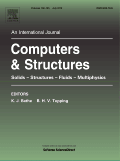
COMPUTERS & STRUCTURES
Transforming Engineering with Computational InsightsCOMPUTERS & STRUCTURES is a leading interdisciplinary journal published by Pergamon-Elsevier Science Ltd, focusing on the application of computer methods in the fields of civil and structural engineering, mechanical engineering, materials science, and modeling and simulation. With a prestigious history dating back to its inception in 1971, this journal is committed to advancing the knowledge and methodologies that integrate computational techniques with structural analysis and design. Recognized in 2023 with a Q1 ranking across several categories, including Civil and Structural Engineering and Computer Science Applications, COMPUTERS & STRUCTURES emphasizes the importance of innovative research that pushes the boundaries of traditional engineering practices. Although the journal does not currently offer open access, it remains an invaluable resource for researchers, professionals, and students seeking to disseminate and discuss groundbreaking findings that are shaping the future of engineering and materials science. The rigorous peer-review process ensures the publication of high-quality articles that contribute to the global discourse in these critical fields.

Journal of Civil Structural Health Monitoring
Leading the charge in civil structural health advancements.The Journal of Civil Structural Health Monitoring, published by SPRINGER HEIDELBERG, is a premier academic journal dedicated to advancing the field of civil and structural engineering, with a specific focus on the health monitoring of infrastructure systems. With an ISSN of 2190-5452 and an E-ISSN of 2190-5479, the journal has established itself as a leading source of rigorous research, evidenced by its impressive Q1 rankings in both Civil and Structural Engineering and Safety, Risk, Reliability, and Quality categories for 2023. As a widely respected platform, the journal offers researchers and practitioners access to high-impact studies, innovative technologies, and insights into the ongoing efforts to enhance infrastructure resilience. Despite its lack of an open-access model, the journal's content is accessible through institutional libraries, ensuring that a wide audience of engineers and scientists can benefit from the latest advancements. With its converged years from 2011 to 2024, the journal continues to play a vital role in shaping best practices and policy decisions in civil engineering, making it an invaluable resource for professionals, scholars, and students alike.
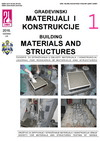
Gradevnski Materijiali I Konstrukcije-Building Materials and Structures
Innovating materials, building a resilient tomorrow.Gradevnski Materijiali I Konstrukcije - Building Materials and Structures is a premier open-access journal dedicated to advancing the field of construction materials and structural engineering. Published by SOC MATERIALS & STRUCTURES TESTING SERBIA, this journal provides a platform for researchers, professionals, and students to share their innovative findings and developments in building materials. With a commitment to open-access since 2012, it fosters unrestricted availability of research for a wider audience, encouraging collaboration and knowledge dissemination. The journal features a diverse range of topics, including material testing, structural integrity, and sustainable construction practices, making it a vital resource for those engaged in the design and analysis of structural components. By fostering the advancement of research and practice in this crucial sector, Gradevnski Materijiali I Konstrukcije plays an essential role in shaping the future of construction and material science.
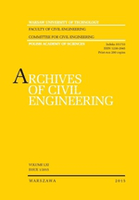
Archives of Civil Engineering
Fostering Collaboration in Structural EngineeringArchives of Civil Engineering is a premier academic journal published by POLISH ACAD SCIENCES, dedicated to advancing the field of civil and structural engineering. Established in 1996, this open-access journal has been pivotal in disseminating high-quality research and innovation in engineering practices, particularly since adopting open access in 2010. With an ISSN of 1230-2945 and E-ISSN of 2300-3103, it enjoys a notable reputation, currently ranked in Q3 of the Civil and Structural Engineering category for 2023, reflecting its considerable contribution to scholarly content in the discipline. The journal caters to a diverse audience of researchers, professionals, and students, providing them with a platform to share and access essential findings. Its commitment to high academic standards is underscored by its ranking in Scopus, where it stands at Rank #265/379. Located in Warsaw, Poland, the journal aims to promote international collaboration and foster knowledge exchange in civil engineering, making it an indispensable resource for anyone involved in this dynamic field.